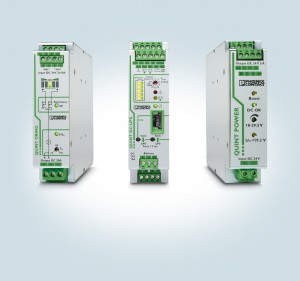Two active Quint Oring redundancy modules are new in the Phoenix Contact product range. They increase the operational reliability by monitoring the redundant power supply solution from the output voltages of the power supplies through the power supply wiring up to the load, as well as the decoupling section up to the load current.
They identify and provide advance warning about critical operating states. For instance, these devices signal incorrect wiring or defective cables, which, up until now, was not possible to this extent.
The newly developed ACB (Auto Current Balancing) technology of the modules doubles the lifetime of the redundantly operated power supplies, ensuring that both power supplies have the same load. The load current is automatically and symmetrically distributed. Permanently monitoring the load current offers an important advantage: If additional loads are connected to a redundant power supply when expanding the plant or system, then this can cause redundancy to be lost. The plant operating company can immediately identify if redundancy no longer exists, as the module signals the overload condition.

The devices with 2×10 A (1×20 A) and 2×20 A (1×40 A) are suitable for voltages from 18 up to 30 V DC. The modules, which are only 32 or 38 mm wide, are simply snapped onto mounting rails. Fit to cope with harsh industrial conditions, they operate at ambient temperatures extending from -25 up to +70 °C.
For ambient temperatures up to +40 °C, continuous currents of 2×15 A or 2×26 A can be provided. The redundancy module uses MOSFETs for decoupling instead of the usual Schottky or silicon diode, therefore saving up to 70 percent energy. Using two positive output terminals, the wiring can be redundantly routed to the loads.
—
Want to find out more? Feel free to contact us at marketing@phoenixcontact.com.sg!

